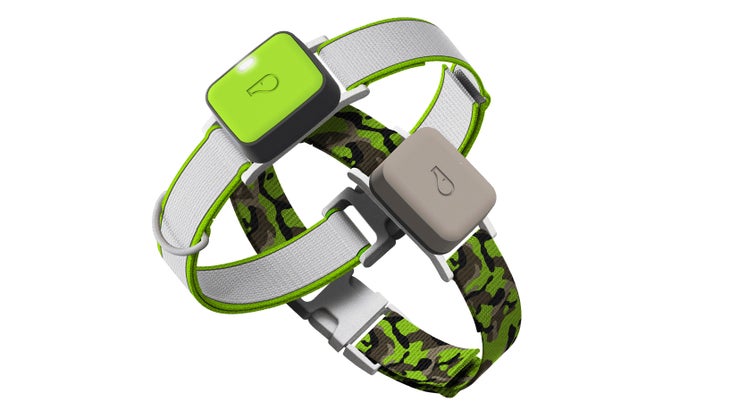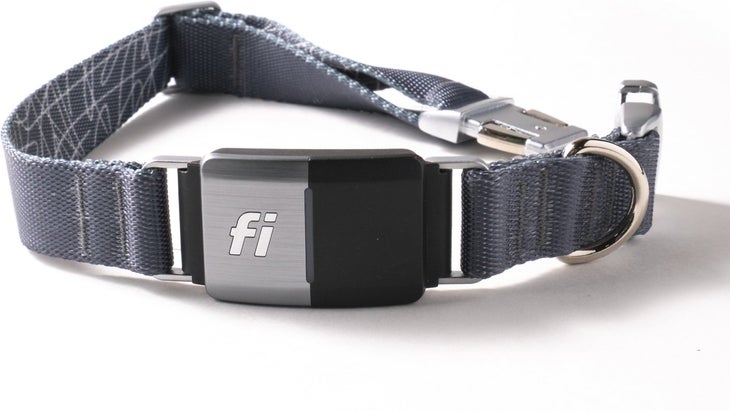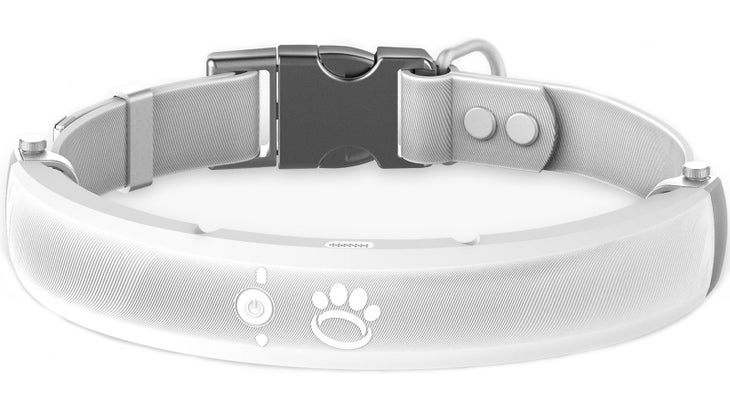The Unsuccessful Intersection of Dogs and Technology
I can use all the help I can get trying to manage my three big, willful dogs at home and in the outdoors. So I understand the desire to apply the same tech solutions that have made work and home more convenient, more connected, and safer to dog ownership. I’ve tried connected dog trackers with great enthusiasm. But after some testing, I found them all lacking. Let me save you time and money by explaining where they went wrong and point you toward the products and training approaches that actually work.
What Are These Gadgets?
Whistle, Fi, and Halo all fall into a new category of product known as connected dog collars. Each one offers some degree of location or activity tracking—or in the case of Halo, training and geofencing—while connecting to your smartphone through Bluetooth, cellphone signal, or WiFi. These aren’t the only connected dog collars on-sale right now, but these three products are the most well known, and together represent all technologies currently available in the space.

Whistle
Whistle currently offers two devices: an $80 motion-based fitness tracker and a $150 unit that adds live GPS tracking. Both are small, unobtrusive, and clip to your dog’s existing collar. Using the Whistle app, you can define a perimeter around your yard and receive an alert if your dog leaves that area. In addition to tracking exercise intensity and duration, Whistle’s motion sensors are equipped with algorithms designed to identify and alert you of problem behaviors like licking and scratching. Fitness tracking plans start at $5 per month; location tracking starts at $8.25. Battery life for the GPS tracker is said to be three days if the dog is away from your WiFi connection.

Fi
The $150 Fi Series 2 collar offers a very similar feature set to Whistle. It provides GPS location tracking and alerts if your dog leaves a designated area, as well as activity tracking. Its main advantage appears to be battery life, with up to three weeks of run time if your dog is away from WiFi signal (which I assume it will be on any walk). Fi’s monthly subscription starts at $7.50 per month.

Halo
By offering a shock-based training and geo-fence aid, Halo promises substantially more function than Whistle or Fi. And, for $1,000-per-collar, with a $2.70 monthly subscription fee, it better. But Halo’s unique selling point is clear: with the tagline “The go-anywhere wireless fence,” the brand says its product will contain your dog within custom areas you can define anywhere, at home or away. Halo works with celebrity dog trainer Cesar Millan and runs owners through a mandatory 21-day training school on the app that teaches them how to humanely and productively apply shock training to their dogs. You need to recharge your Halo collar every night.
The First Problem: Cell Phone Reception
Take your dog for a walk around town, and you’ll probably notice that the number of signal bars on your phone varies as you walk past tall buildings, through heavily wooded areas, or up and down hills. That’s because the UHF radio frequencies that your phone uses to communicate with a cell tower must travel in a straight line between source and receiver. In other words, cell phone signal is line-of-sight—physical obstructions between your phone and a tower can block it.
The problem likely gets worse if you take your dog on a hike outside of town. While all of these devices are capable of receiving location information from GPS satellites, they transmit that location to your phone using cellular phone networks. The potential for problems double, because we’re talking about two devices here: the collar on your dog, and the phone in your hand. The second either one of those loses its cell signal, you lose the ability to track your dog.
This problem was evident testing Whistle back in Los Angeles, where I used to live. My favorite spot to hike the dogs there was Runyon Canyon, a mega-popular city park in the Hollywood Hills. There, we found cellphone blackout areas at the bottom of the park’s canyons and the crowded trailhead on the park’s south side. Whistle wasn’t able to track dogs or communicate with my cell phone through parts of the most popular dog park in LA.
Bluetooth Is Patchy, Too
Borrowed or rented a car lately? Shared a wireless speaker with your partner? We all know how challenging it can be to pair your phone with another device using Bluetooth, maintain that connection as you leave and return to an area, and share a device with multiple users.
Bluetooth-enabled devices transmit radio signals on the same frequency as other wireless gadgets, like baby monitors and cordless phones—the same frequency emitted by microwaves and fluorescent lights. All of our homes and public spaces are packed full of devices that compete for that frequency or interfere with it. Smart collars also use Bluetooth to communicate with your phone when they’re in close proximity for functions like setting changes, or in the case of Halo, training inputs.
The first step to using any shock collar is to put it on your dog, and begin testing to see what degree of shock is needed to elicit a response. As I’ve explored at length, the humane use of shock in dog training relies on finding the minimum effective dose that works on your dog. The goal isn’t to hurt them; it’s to establish a clear and immediate communication cue. So new Halo in hand, I fitted it to our middle dog, Bowie, used my paired phone to set the shock function to its lowest setting, and began pushing the test button in the app to transmit shocks.
Or at least I thought I did. An athletic 75-pound husky-German shepherd mix, Bowie is a tough little guy, so I wasn’t surprised when I’d moved through the first half of shock intensity without seeing any sort of reaction. I kept turning the level up and pushing the button to fire the shock until I’d reached the maximum level. The app’s interface kept telling me it was working, but Bowie was just sniffing around like usual, unbothered. So I pushed the shock button a few more times. All of a sudden, Bowie did a giant backflip while letting out an awful yelp. Turns out my phone hadn’t been communicating with the collar, so the first shock he received was at one of the highest levels. I took his collar off and didn’t try it again until a couple weeks had passed.
Aside from trouble reliably transmitting training cues, Bluetooth also suffers from a limited range (typically 30 feet or so, not enough to cross my backyard) and generally unreliable connection. The technology throws a wrench in the ability of any of these products’ ability to provide consistent training cues or assured safety.
GPS Locations Can Be Imprecise
The Global Positioning System is a series of 24 satellites launched and controlled by the Department of Defense. Each of those satellites constantly transmits its location and the exact time. To determine its location, the GPS receiver on your device looks at the signals transmitted by at least four of those satellites and compares the time it took those signals to arrive to calculate its position on earth in three dimensions.
Buildings, trees, terrain, and other obstructions can block satellite transmissions. So while the best-case scenario accuracy level for any of these devices is seven feet or less, that number can rapidly grow, depending on your surroundings.
While simply tracking a dog, temporary variances in location accuracy shouldn’t be a major problem. If your dog is 100 yards ahead of you on the trail, it doesn’t really matter if your display is saying 99 or 110 yards. But variances in accuracy can cause issues when it comes to geo fencing.
Testing Whistle and Fi’s escape alert functions by having a friend leash up one of the dogs and walk them away from the house, neither product proved able to reliably provide an alert of the dog’s “escape” until they were well away from the house. In some cases, that alert came after they’d moved a couple blocks away, across a couple of major roads.
In the case of Halo, location accuracy problems proved more fundamental. I wanted to use it to contain the dogs within the yard of our cabin. Since it’s located near Glacier National Park, there are large predators like grizzly bears and wolves in the immediate vicinity, but the lake it’s located on also freezes over in the winter, and that ice is often of dubious thickness. Keeping the dogs in the yard is a matter of life or death.
I tested Halo’s accuracy by holding two collars in my hand and moving around and off my cabin’s property. I was sometimes able to walk out onto the ice with no feedback from the collars whatsoever, and up into the wooded hills on the other side, again with no reaction from the collars. In other cases, the collars would skip the audible warnings and move straight to applying shocks. Sometimes, the shocks would come at the precise border I’d defined, and other times those shocks would occur ten yards or more past that point.
Fitting the collar to Wiley, our oldest, and most strong-headed dog, I noticed him receive a correction at the border of the property, then continue his adventure onwards, unchecked.
Given that the purpose of a shock collar is to provide consistent, immediate, clear training cues, this is incredibly problematic. By failing to reliably alert my dogs of the border of the property, they weren’t able to receive effective training to stay within it. And by applying shock unpredictably, Halo created the risk of frightening the dogs and causing them to run further into danger.
I have since given the collars to friends who live on a ranch outside of town, here in Montana. Their property is all grassland, with an unobstructed view of the sky and covered in strong, consistent cellphone signal. It’s not near any roads or other major dangers. In that best-case environment, they have found that Halo is able to keep their small dogs from visiting the nearest neighbors, several hundred yards away.

So What Works?
Despite the frustrations I ran into testing these collars, I am successfully able to keep my dogs contained at home, at the cabin, or in camp and can even track them when they’re off-leash. Heck, I even know how much exercise they get. Here’s how.
Dog Containment
To keep our dogs in the yard and off the busy street we live on here at home in Bozeman, Montana, I built a six-foot tall fence. The total cost? $5,000. Or only $2,000 more than the cost of three Halo collars. And that fence is 100 percent reliable—as long as my friends remember to shut the gate.
At the cabin, I’ve installed a sort of aerial dog run by tensioning a strong rope at head height between two trees. Clipping the dogs’ leashes to that allows some small degree of outside activity and bathroom breaks. No matter how I hang it, the dogs always find a way to get tangled, but it is safe. No dog has gotten out on the ice or chased a moose yet.
In camp, I just rely on the recall I’ve built into each dog with years of consistent positive reinforcement training. They’re a ways from being absolutely reliable with a simple call, but I also choose to camp a long ways from other people, so it’s not a huge issue.
Dog Tracking
I use a Garmin Astro 430 and T5 collars. The system isn’t cheap, starting at $650 for the handheld device and a collar, and $250 for each additional collar. And it’s not without its own problems: the interface isn’t very user friendly, the handheld receiver runs on expensive lithium batteries that have to be fed every few hours of use, and the collars use a proprietary charger that you have to buy a new collar to replace. But man, this thing is reliable.
Unlike the collars mentioned above, Garmin employs a radio transmitter (the big antennae you can see the my dogs wearing in the photo on top of this article) to transmit the location of each device back to the handheld receiver. That gives the Astro a nine-mile range between human and dog, even in heavily wooded mountains. The collars are also made from the kind of robust materials—nickel-plated steel hardware, polyurethane-coated nylon straps—that have stood up to all of the abuse our dogs can throw at them for two years with no signs of wear. While the big antennae might seem awkward, our dogs have never gotten them stuck on anything, and so far as I can tell, don’t even notice they’re there.
Fitness Tracking
Each of the dogs got about ten miles of moderately-paced hiking in last Saturday. How do I know that? I clipped on their leashes, put on my boots, and took them on a ten-mile hike. I can tell how far we went by looking at a map and watching the terrain we cross. I can gauge how they’re doing by observing their body language. And I can determine if it was enough exercise by whether or not they fall asleep when we get home. I don’t need an app to tell me that stuff, and neither do you.

